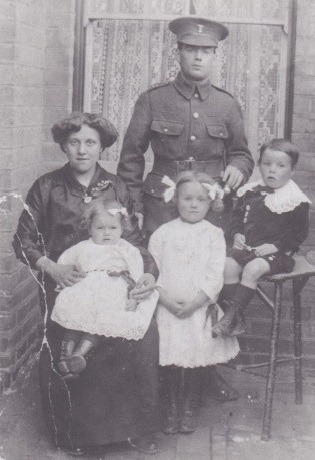Pte
Robert Roberts
Information about birth
|
Year of birth: 1888 |
|
Place of birth: Brymbo, Wrexham, Denbigh, Wales, United Kingdom |
General information
|
Profession: Brass Finisher |
Army information
|
Country: Ireland, United Kingdom |
|
Force: British Expeditionary Force |
|
Rank: Private |
|
Service number: 17449 |
|
Enlistment place: Birmingham, Warwickshire, England, United Kingdom |
|
Units: — Royal Irish Fusiliers, 9th Bn. (Last known unit) |
Information about death
|
Date of death: 16/08/1917 |
|
Place of death: Pommern Castle & Redoubt, Zonnebeke, Belgium |
|
Cause of death: Killed in action (K.I.A.) |
|
Age: 29 |
Cemetery
|
Tyne Cot Cemetery Plot: VI Row: D Grave: 15 |
Distinctions and medals 2
|
British War Medal Medal — 13/11/1920 |
|
Victory Medal Medal — 13/11/1920 |
Points of interest 3
| #1 | Place of birth | ||
| #2 | Enlistment place | ||
| #3 | Place of death (approximate) |
My story
Private Robert Roberts, a 29-year-old brass finisher from Birmingham, Warwickshire fell in battle on 16 August 1917. At the time of his death, Robert was serving with the 9th Battalion Royal Irish Fusiliers, part of the 108th Brigade of the 36th (Ulster) Division.
On 16 August 1917, the 9th Royal Irish Fusiliers assembled in an old trench that ran from Pommern Redoubt (headquarters) to Iberian Farm. They had to advance towards the Zonnebeke-Langemark road. A few moments after advancing behind the barrage, the men were already stopped at Hill 35. But despite sustained machine-gun fire from Somme and Gallipoli, the battalion managed to capture Hill 35. Meanwhile, the 7/8th Royal Irish Fusiliers got ahead of them and so did the barrage. A platoon was left behind to consolidate Hill 35 while the attack continued. The 9th Royal Irish Fusiliers advanced until they reached a double row of barbed wire south and east of Gallipoli. The wire was cut in only one or two places and this stopped the advance. German machine-gun fire was brought down on them from dugouts in Gallipoli, Aisne House, Martha House and from Hill 37, causing many casualties.
It proved impossible to continue and the battalion was forced to retreat, consolidating positions near a trench running alongside Hill 35. But continuing machine-gun fire from Hill 37 beleaguered this position and again the battalion was forced to retreat, this time to a trench running southwards on Hill 35. This position was consolidated and held until the 16th (Irish) Division to their right was pushed back by German counterattacks. With their right flank in the air and enfilade fire from Iberian Farm, the 9th Royal Irish Fusiliers had no choice but to eventually withdraw to their original positions.
Private Robert Roberts was killed in the attack on Hill 35, leaving behind his wife Louisa and their three children. Robert was buried in the field near Pommern Castle & Redoubt in Zonnebeke. His remains were exhumed after the war and interred at Tyne Cot Cemetery.
On 16 August 1917, the 9th Royal Irish Fusiliers assembled in an old trench that ran from Pommern Redoubt (headquarters) to Iberian Farm. They had to advance towards the Zonnebeke-Langemark road. A few moments after advancing behind the barrage, the men were already stopped at Hill 35. But despite sustained machine-gun fire from Somme and Gallipoli, the battalion managed to capture Hill 35. Meanwhile, the 7/8th Royal Irish Fusiliers got ahead of them and so did the barrage. A platoon was left behind to consolidate Hill 35 while the attack continued. The 9th Royal Irish Fusiliers advanced until they reached a double row of barbed wire south and east of Gallipoli. The wire was cut in only one or two places and this stopped the advance. German machine-gun fire was brought down on them from dugouts in Gallipoli, Aisne House, Martha House and from Hill 37, causing many casualties.
It proved impossible to continue and the battalion was forced to retreat, consolidating positions near a trench running alongside Hill 35. But continuing machine-gun fire from Hill 37 beleaguered this position and again the battalion was forced to retreat, this time to a trench running southwards on Hill 35. This position was consolidated and held until the 16th (Irish) Division to their right was pushed back by German counterattacks. With their right flank in the air and enfilade fire from Iberian Farm, the 9th Royal Irish Fusiliers had no choice but to eventually withdraw to their original positions.
Private Robert Roberts was killed in the attack on Hill 35, leaving behind his wife Louisa and their three children. Robert was buried in the field near Pommern Castle & Redoubt in Zonnebeke. His remains were exhumed after the war and interred at Tyne Cot Cemetery.
Sources 5
|
9 Battalion Royal Irish Fusiliers (The National Archives, Kew (TNA), WO 95/2505/2). https://www.nationalarchives.gov.uk/ Sources used |
|
Census Returns of England and Wales, 1911 (The National Archives, Kew (TNA), RG14). https://www.nationalarchives.gov.uk/ Sources used |
|
Cunliffe, M., Passchendaele: The Royal Irish Fusiliers : 1793-1968. (Oxford, Oxford University Press, 1970) 324-327. Sources used |
|
Harris, H., The Royal Irish Fusiliers (the 87th and 89th Regiments of Foot). (London, Leo Cooper, 1972) 100-103. Sources used |
|
McCarthy Chris, Passchendaele: The Day-By-Day Account (Londen, Arms & Armour, 2018) 52-55. Sources used |
More information 3
|
Commonwealth War Graves Commission Database https://www.cwgc.org/find-records/find-war-dead/casualty-details/464451 |
|
Lives of the First World War (Imperial War Museum) https://livesofthefirstworldwar.iwm.org.uk/lifestory/3769414 |
|
Namenlijst (In Flanders Fields Museum) https://namenlijst.org/publicsearch/#/person/_id=5120a3b1-f2a6-4b14-a86a-deca6c709999 |
